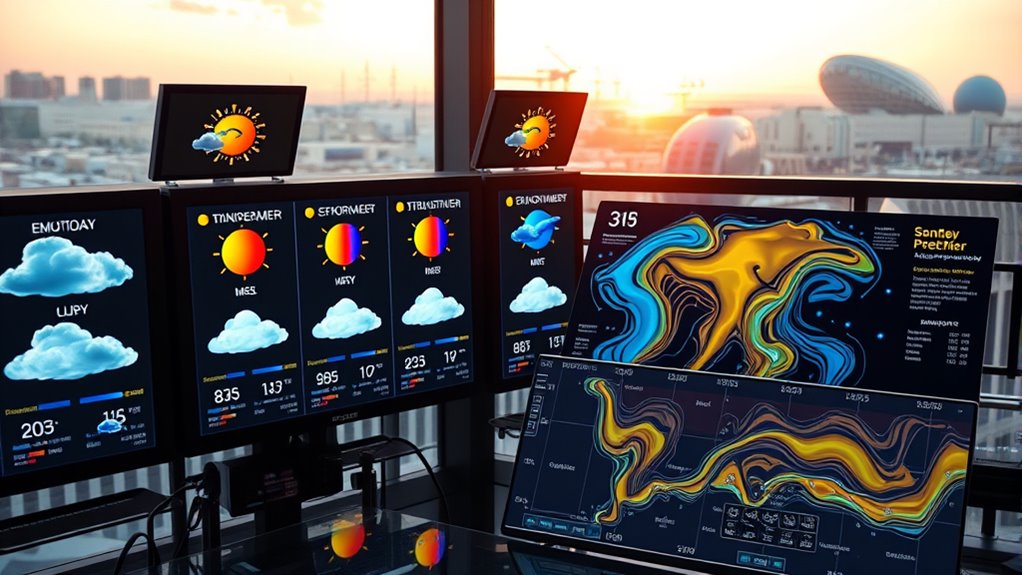Tracking your emotional weather alongside forecasts helps you understand how environmental factors influence your mood and decision-making. Using technologies like wearable sensors, sentiment analysis, and mood journaling apps, you can gather personalized data about how weather and external cues affect your mental state. Combining this with traditional weather reports offers a holistic view of your well-being and routines. If you continue exploring, you’ll uncover how integrating these insights can boost your mental resilience and daily harmony.
Key Takeaways
- Integrate physiological sensors, mood journaling apps, and facial recognition software to monitor emotional states in real-time.
- Use sentiment analysis of social media and surveys to gauge collective emotional weather alongside weather forecasts.
- Combine environmental data with emotional tracking to identify weather-related mood patterns and improve personalized mental health strategies.
- Leverage wearable devices and AI algorithms to analyze emotional fluctuations linked to weather changes.
- Address privacy concerns by implementing secure data handling and transparent consent processes in emotional weather tracking systems.
The Evolution of Weather and Mood Tracking
Throughout history, humans have sought ways to understand and predict both the weather and their own emotional states. This curiosity led to the development of climate psychology, which explores how environmental factors influence mood and behavior. Over time, people began using mood tracking to monitor emotional patterns, much like weather forecasting. Early methods included journals and diaries, documenting daily feelings alongside weather conditions. Today, technology has advanced these practices with apps and wearable devices that automatically log mood data. This evolution highlights a deeper understanding: just as weather impacts daily life, emotional weather influences well-being. Recognizing the impact of environmental factors on mood can also improve your overall resilience and emotional intelligence. Modern data collection techniques allow for more precise analysis and personalized insights into how surroundings affect mental health, emphasizing the importance of environmental awareness in emotional regulation. Being aware of emotional weather patterns can help individuals develop better coping strategies and foster a greater sense of balance.
How Emotional Weather Can Impact Daily Life

Your emotional weather can influence your mood, making some days feel brighter or gloomier. These fluctuations can challenge your decision-making and impact how you handle tasks. As a result, your productivity may vary depending on how you’re feeling inside. Monitoring emotional health can help you better understand and manage these emotional shifts. Recognizing how sleep routines affect emotional well-being can further support your overall mental health and resilience. Developing digital literacy skills can empower you to identify and address online influences that may affect your emotional state. Additionally, understanding the importance of regular well-being tips can aid in establishing routines that promote emotional stability. Awareness of angel numbers and their messages can also provide additional emotional guidance and reassurance during uncertain times.
Mood Fluctuation Effects
When emotional weather shifts unexpectedly, it can profoundly influence your mood and daily interactions. For example, seasonal affective patterns might cause you to feel more sluggish or irritable during certain times of the year, leading to mood swings that disrupt your focus. These fluctuations can make it hard to stay consistent in your activities or relationships. You might find yourself feeling more optimistic one day and suddenly overwhelmed the next, depending on external emotional cues. Recognizing these mood fluctuation effects helps you understand that emotional weather is a natural part of life. By tracking these patterns, you can better manage your responses and develop strategies to maintain balance, even when the emotional forecast is unpredictable. Understanding emotional weather can also help you identify recurring patterns of mood change linked to external or internal factors. Monitoring mood fluctuations allows you to anticipate and prepare for emotional shifts more effectively. Incorporating awareness of sound design techniques, such as ambient soundscapes, can also help modulate emotional states and create a calming environment during turbulent times. Additionally, practicing mindfulness can enhance your ability to stay present and adapt to changing emotional conditions. Moreover, recognizing the influence of seasonal patterns can help you prepare for times when your mood may naturally fluctuate due to external seasonal changes.
Decision-Making Challenges
Emotional weather can profoundly influence your decision-making process, often causing you to second-guess choices or delay important actions. When your mood shifts unpredictably, it becomes harder to rely on rational judgment, impacting your climate resilience and daily goals. Recognizing how emotional weather interacts with meteorological models helps you understand these internal fluctuations. Consider this table:
| Emotional State | Decision Impact | Suggested Approach |
|---|---|---|
| Stormy | Hesitation, impulsivity | Pause, gather facts |
| Sunny | Confidence, clarity | Proceed with plans |
| Overcast | Uncertainty, doubt | Reflect, seek advice |
Additionally, understanding trustworthiness of Patchology can offer insights into how the credibility of skincare brands influences consumer confidence during emotional highs and lows. Being aware of your emotional weather patterns can help you develop better strategies for managing your responses during unpredictable times. Incorporating mindfulness techniques can also enhance your ability to stay centered amid fluctuating internal climates. Recognizing the influence of holistic care models on well-being can further support balanced decision-making in uncertain moments.
Productivity Variability
The fluctuating nature of emotional weather directly influences your daily productivity, shaping how effectively you complete tasks and maintain focus. When emotional weather shifts unpredictably, it creates meteorological impacts on your motivation, energy, and decision-making. You might find yourself more productive on days with positive emotional climates, while storms of stress or sadness can hinder progress. To adapt, you need climate adaptation strategies that help you manage emotional variability. Recognizing patterns allows you to anticipate lows and optimize high-energy periods. By tracking emotional weather alongside forecasts, you can better prepare for productivity dips, minimize disruptions, and create environments that support emotional resilience. Understanding the impact of mental health on daily functioning can further enhance your ability to navigate emotional fluctuations, ensuring that meteorological impacts on your emotional weather don’t derail your goals.
Technologies Behind Emotional Forecasting

You can use sentiment analysis techniques to interpret emotions from social media, surveys, or wearable data. These methods help gather emotional data quickly and accurately. Understanding the technologies behind emotional forecasting reveals how insights are generated and applied.
Sentiment Analysis Techniques
Sentiment analysis techniques form the backbone of emotional forecasting by enabling computers to interpret and quantify human emotions expressed in text. You leverage linguistic nuance to distinguish subtle differences in tone, sarcasm, or context that influence emotional meaning. Machine learning algorithms play a pivotal role, learning from vast datasets to improve accuracy over time. These systems analyze language patterns, word choice, and syntax to identify positive, negative, or neutral sentiments. By capturing the complexity of human expression, you can better understand emotional states and trends. Advanced methods, like deep learning, further enhance the ability to recognize nuanced emotional cues. Ultimately, these techniques help translate raw text into meaningful emotional insights, supporting more precise and responsive emotional weather forecasts.
Emotional Data Collection
Advancements in emotional data collection rely on a variety of technologies that capture human emotions from multiple sources in real-time. Wearable sensors monitor physiological indicators like heart rate and skin conductance, providing insights into emotional states. Mood journaling apps enable you to log feelings throughout the day, helping identify patterns and build emotional resilience. Facial recognition software analyzes expressions to assess mood shifts accurately. Voice analysis tools detect emotional nuances in speech, offering another data stream. These technologies work together to create a holistic emotional profile, allowing for more precise emotional forecasting. By combining physiological data, self-reported moods, and behavioral cues, you can better understand your emotional weather and develop strategies to manage it effectively.
Integrating Emotional Data With Traditional Weather Reports

While traditional weather reports provide essential data about temperature, precipitation, and wind, integrating emotional data adds a new dimension that captures how people feel in response to weather conditions. By combining emotional insights with forecast data, you can better understand community moods and emotional resilience during extreme weather events. This integration supports climate adaptation efforts by highlighting how weather impacts mental well-being, prompting more targeted support and resources. It also helps authorities and individuals prepare psychologically for adverse conditions, fostering emotional resilience. When emotional data is incorporated into weather reports, it encourages a holistic approach that considers both physical and mental health, ultimately leading to more effective responses and improved overall well-being in the face of climate variability.
Benefits of Personalizing Emotional Insights

Personalizing emotional insights in weather reports allows you to better understand how individual reactions vary based on personal experiences and circumstances. When you track your mood through journaling, you gain a clearer picture of how weather patterns influence your emotional resilience. Recognizing these patterns helps you develop strategies to manage stress or mood swings more effectively. By tailoring emotional insights to your unique responses, you can identify triggers and anticipate emotional shifts, leading to better self-awareness. This personalized approach empowers you to adapt your routines and coping mechanisms, making you more resilient during challenging weather conditions or emotional lows. Ultimately, it fosters a deeper connection between your environment and emotional well-being, helping you navigate daily life with greater clarity and control.
Challenges in Monitoring Emotional States

Monitoring emotional states can be difficult because emotions are often fleeting and complex, making them hard to track consistently. Sensor limitations pose a significant challenge, as current devices may not accurately capture subtle emotional cues or may produce unreliable data. For example, wearable sensors might miss context or misinterpret physiological signals, leading to inaccurate assessments. Additionally, data privacy concerns hinder ongoing monitoring efforts. Collecting sensitive emotional information raises questions about consent, data security, and potential misuse. These issues can make you hesitant to adopt or trust emotional tracking technologies. Overcoming these challenges requires advancements in sensor technology to improve accuracy and robust privacy safeguards to protect your personal information, ensuring that emotional data is handled ethically and securely.
Practical Applications for Mental Well-being
Advances in emotional tracking technology open up new opportunities to support your mental well-being in everyday life. By integrating emotional data with meteorological models, you can better understand how external factors like climate change influence your mood. For example, tracking emotional weather patterns can help you anticipate periods of heightened stress during severe weather events or seasonal changes. Mental health apps that connect emotional states to weather forecasts empower you to develop coping strategies, such as relaxation techniques during gloomy days or outdoor activities on sunny days. These tools make it easier to recognize emotional trends linked to environmental shifts, fostering resilience and self-awareness. Ultimately, combining emotional tracking with weather insights provides a personalized approach to maintaining mental well-being amid our changing climate.
Ethical Considerations and Privacy Concerns

As emotional tracking technology becomes more integrated into daily life, ethical considerations and privacy concerns naturally arise. You must think about privacy safeguards that protect sensitive data and ensure consent. Without clear ethical frameworks, misuse or misinterpretation of emotional data could occur, harming trust. To visualize this, consider the following table:
| Privacy Safeguards | Ethical Frameworks | Emotional Data Impact |
|---|---|---|
| Data encryption | User consent policies | Mental well-being effects |
| Anonymization | Transparency standards | Emotional privacy risks |
| Limited access | Accountability measures | Data misuse consequences |
Balancing innovation with responsibility requires strict privacy safeguards and ethical frameworks. These measures help maintain user trust and prevent potential harm from emotional data misuse.
Future Directions for Holistic Weather and Mood Forecasts

The future of all-encompassing weather and mood forecasts lies in integrating real-time emotional data with traditional environmental metrics, creating a more extensive picture of daily well-being. By combining weather patterns and mood regulation insights, you’ll gain a deeper understanding of how external factors influence mental health. This holistic approach can improve personalized interventions, enhance mood prediction accuracy, and promote better mental resilience strategies. As technology advances, expect more intuitive tools that analyze both environmental conditions and emotional states simultaneously. These innovations could help you anticipate emotional shifts caused by weather changes, fostering proactive mood management. To deepen your understanding, consider how integrating physiological data, AI-driven analytics, community feedback, and personalized recommendations can revolutionize mental health support in weather forecasting.
Frequently Asked Questions
How Reliable Are Emotional Weather Predictions Compared to Traditional Forecasts?
You might wonder how reliable emotional weather predictions are compared to traditional forecasts. While sensors can detect emotional cues, their accuracy depends on data privacy and sensor precision. Unlike weather forecasts, which rely on established science, emotional predictions are more subjective and less consistent. You should consider these factors, as privacy concerns can affect data quality, making emotional weather predictions less dependable than traditional forecasts.
Can Emotional Weather Data Predict Mental Health Crises?
You wonder if emotional weather data can predict mental health crises. While it offers insights into emotional contagion and mood regulation, it’s not foolproof. You might see patterns indicating stress or anxiety, but predicting crises remains complex. Emotional weather provides valuable clues, yet it’s just a piece of the puzzle. You need all-encompassing support, combining emotional data with clinical insights, to better anticipate and manage mental health challenges effectively.
What Are the Costs Associated With Emotional Weather Tracking Technologies?
When considering emotional weather tracking technologies, you should weigh the costs like privacy concerns and data accuracy. These systems often collect sensitive information, risking your personal privacy if mishandled or hacked. Additionally, inaccurate data can lead to misguided interventions or false alarms. You might also face financial costs for devices or subscriptions, but understanding these risks helps you decide whether the benefits outweigh potential drawbacks.
How Do Cultural Differences Influence Emotional Weather Perceptions?
Imagine you’re in the 21st century, yet cultural expressions still shape how you perceive emotional weather. Cultural differences influence emotional dialects, making some feelings more acceptable or visible in certain societies. These perceptions aren’t universal; they’re shaped by traditions, language, and social norms. So, when you interpret emotional weather, remember that your cultural background colors your understanding, leading to diverse emotional landscapes worldwide.
Will Emotional Weather Tracking Become a Standard Part of Daily Forecasts?
You might wonder if emotional weather tracking will become a standard part of daily forecasts. It’s possible, as understanding emotional resilience and mood regulation is increasingly valued. Including such data could help you better manage your mental health, just like physical weather updates help plan your day. As technology advances, integrating emotional insights into daily forecasts could become common, guiding you to adapt and stay balanced amid life’s ups and downs.
Conclusion
As you start tracking your emotional weather alongside forecasts, you realize how interconnected your mood is with the world around you. Sometimes, a sunny outlook can brighten your day, just like clear skies. Other times, storms within mirror external storms. By embracing this holistic view, you discover that understanding your emotional climate isn’t just coincidence—it’s a key to steering life’s unpredictable weather with resilience and hope.









